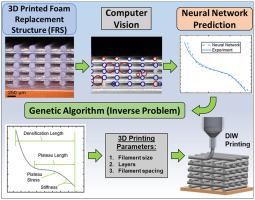Additive Manufacturing ( IF 10.3 ) Pub Date : 2021-03-20 , DOI: 10.1016/j.addma.2021.101950 Devin J. Roach , Andrew Rohskopf , Craig M. Hamel , William D. Reinholtz , Robert Bernstein , H. Jerry Qi , Adam W. Cook

|
Additive Manufacturing (AM) of porous polymeric materials, such as foams, recently became a topic of intensive research due their unique combination of low density, impressive mechanical properties, and stress dissipation capabilities. Conventional methods for fabricating foams rely on complex and stochastic processes, making it challenging to achieve precise architectural control of structured porosity. In contrast, AM provides access to a wide range of printable materials, where precise spatial control over structured porosity can be modulated during the fabrication process enabling the production of foam replacement structures (FRS). Current approaches for designing FRS are based on intuitive understanding of their properties or an extensive number of finite element method (FEM) simulations. These approaches, however, are computationally expensive and time consuming. Therefore, in this work, we present a novel methodology for determining the mechanical compression response of direct ink write (DIW) 3D printed FRS using a simple cross-sectional image. By obtaining measurement data for a relatively small number of samples, an artificial neural network (ANN) was trained, and a computer vision algorithm was used to make inferences about foam compression characteristics from a single cross-sectional image. Finally, a genetic algorithm (GA) was used to solve the inverse design problem, generating the AM printing parameters that an engineer should use to achieve a desired compression response from a DIW printed FRS. The methods developed herein present an avenue for entirely autonomous design and analysis of additively manufactured structures using artificial intelligence.
中文翻译:

利用计算机视觉和人工智能算法来预测和设计直接墨水写入3D打印泡沫替换结构的机械压缩响应
多孔聚合物材料(例如泡沫)的增材制造(AM)最近因其低密度,令人印象深刻的机械性能和应力消散能力的独特结合而成为深入研究的主题。用于制造泡沫的常规方法依赖于复杂且随机的过程,这使得对结构化孔隙率进行精确的建筑控制具有挑战性。相比之下,增材制造提供了访问各种可印刷材料的途径,在制造过程中可以调节对结构化孔隙率的精确空间控制,从而能够生产泡沫替代结构(FRS)。设计FRS的当前方法是基于对其属性的直观理解或大量的有限元方法(FEM)模拟。但是,这些方法 在计算上是昂贵且费时的。因此,在这项工作中,我们提出了一种新颖的方法,用于使用简单的横截面图像确定直接墨水写入(DIW)3D打印的FRS的机械压缩响应。通过获取相对少量样品的测量数据,训练了人工神经网络(ANN),并使用计算机视觉算法从单个横截面图像推断出泡沫压缩特性。最后,遗传算法(GA)用于解决逆向设计问题,生成工程师应使用的AM打印参数,以从DIW打印的FRS获得所需的压缩响应。











































 京公网安备 11010802027423号
京公网安备 11010802027423号